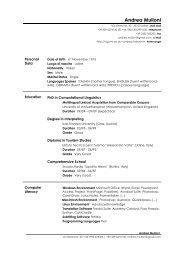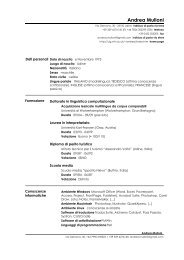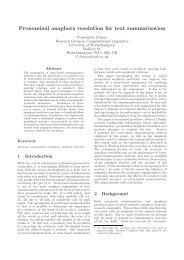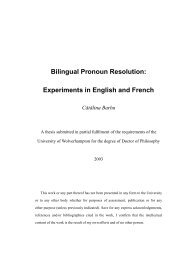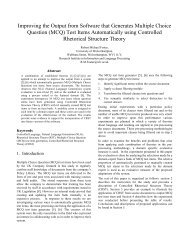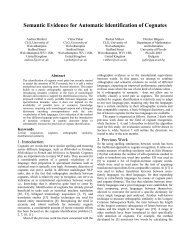Design and development of a concept-based multi ... - Citeseer
Design and development of a concept-based multi ... - Citeseer
Design and development of a concept-based multi ... - Citeseer
You also want an ePaper? Increase the reach of your titles
YUMPU automatically turns print PDFs into web optimized ePapers that Google loves.
Shiyan Ou, Christopher S.G. Khoo <strong>and</strong> Dion H. Goh<br />
Table 2<br />
Example pattern for extracting cause–effect relationship in text<br />
Token effect/influence/ on/in <br />
have * (*) (*) (<strong>and</strong>) (*) impact<br />
Part <strong>of</strong> speech tag NP V DET ADV A CC A V PREP NP<br />
IV indicates an independent variable <strong>and</strong> DV indicates a dependent variable;<br />
( ) indicates an optional cue word;<br />
* indicates a wild card.<br />
variables, whereas the non-slot tokens are cue words which signal the occurrence <strong>of</strong> a relationship.<br />
Each cue word is constrained with a part-<strong>of</strong>-speech tag. Table 2 gives an example pattern that represents<br />
one surface expression <strong>of</strong> cause–effect relationship in the text.<br />
The pattern matches the following sentences, where the extracted independent variables (IVs) <strong>and</strong><br />
dependent variables (DVs) are underlined, <strong>and</strong> their cause–effect relationships are highlighted in bold.<br />
1. Changes in labor productivity have a positive effect on directional movement.<br />
2. Medicaid appeared to have a negative influence on the proportion <strong>of</strong> uninsured welfare leaves.<br />
3. Family structure has a significant impact on parental attachment <strong>and</strong> supervision.<br />
A pattern matching algorithm was developed to look for these relationship patterns in the text.<br />
Pattern matching was focused on the research objectives <strong>and</strong> research results sections to extract<br />
relationships <strong>and</strong> their associated variables. A pattern typically contains one or more slots, <strong>and</strong> the<br />
research <strong>concept</strong> terms that match the slots in the pattern represent the variables linked by the relationship.<br />
Research <strong>concept</strong> terms had been extracted as nouns or noun phrases in an earlier processing<br />
step (see Section 3.3.1).<br />
3.4. Information integration<br />
Information integration includes <strong>concept</strong> integration <strong>and</strong> relationship integration. Concept integration<br />
involves clustering similar <strong>concept</strong>s <strong>and</strong> generalizing them using a broader <strong>concept</strong>. Relationship<br />
integration involves clustering relationships associated with the common <strong>concept</strong>s, normalizing<br />
the different surface expressions for the same type <strong>of</strong> relationship, <strong>and</strong> conflating them into a new<br />
sentence.<br />
In previous studies, two approaches have been used for <strong>concept</strong> generalization. The first<br />
approach is <strong>based</strong> on semantic relations among <strong>concept</strong>s. Lin [14] used computer to generalize<br />
mainframe, workstation, server, PC <strong>and</strong> laptop according to the is-instance-<strong>of</strong> <strong>and</strong> is-subclass-<strong>of</strong><br />
relations in WordNet. This approach requires a thesaurus, taxonomy, ontology, or knowledge base<br />
to provide a meaningful <strong>concept</strong> hierarchy. The second approach is <strong>based</strong> on syntactic relations<br />
among <strong>concept</strong>s. Various syntactic variations have been used by researchers to identify term variants<br />
which are considered to represent similar <strong>concept</strong>s. Borgigault <strong>and</strong> Jacquemin [25] used internal<br />
insertion <strong>of</strong> modifiers, preposition switch <strong>and</strong> determiner insertion to identify term variants.<br />
Ibekwe-SanJuan <strong>and</strong> SanJuan [29] defined two kinds <strong>of</strong> variations – the variations that only affected<br />
modifier words in a term such as left expansion, insertion, <strong>and</strong> modifier substitution <strong>and</strong> the variations<br />
that shared the same head words such as left–right expansion, right expansion <strong>and</strong> head substitution.<br />
In this study, we used the second approach to identify <strong>and</strong> cluster similar <strong>concept</strong>s <strong>based</strong><br />
on two kinds <strong>of</strong> syntactic variations – subclass modifier substitution <strong>and</strong> facet modifier substitution.<br />
3.4.1. Concept clustering <strong>and</strong> generalization<br />
To integrate similar <strong>concept</strong>s, we analyzed the structure <strong>of</strong> <strong>multi</strong>-word terms (<strong>concept</strong>s) <strong>and</strong> found<br />
that the majority can be divided into the following two parts:<br />
• Head noun refers to the noun component that identifies the broader class <strong>of</strong> things or events to<br />
which the term as a whole refers, for example, cognitive ability, educated woman.<br />
Journal <strong>of</strong> Information Science, XX (X) 2007, pp. 1–19 © CILIP, DOI: 10.1177/0165551507084630 7



